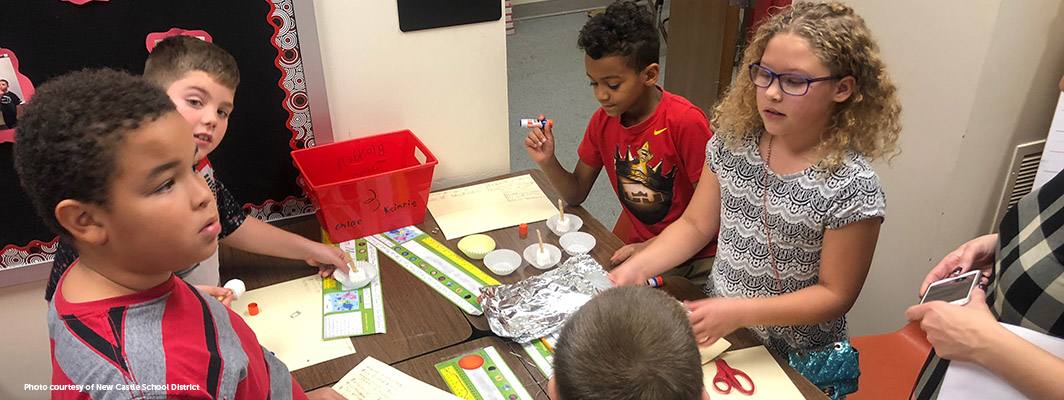
Maker learning is more than just making “stuff.” Schools everywhere have joined the maker movement by creating makerspaces where students can engage in project-based learning and bring their innovative designs to life. Many identify maker learning as a way to promote student agency through design thinking while promoting 21st century skills such as creativity, collaboration, and critical thinking.
In the New Castle Area School District (NCASD), we have embraced the tenets of maker learning as a way to further enhance our district-wide STEM/STEAM program and foster social-emotional learning (SEL) at all grade levels, with an intense focus on grades K-6.
Maker learning is a highly collaborative process that embraces a team approach to learning. In small groups, students plan, design, and build together as a functioning unit. With this approach, we have seen students take on various roles which help them move beyond stereotypes and build empathetic capacity.
According to the Collaborative for Academic, Social, and Emotional Learning (CASEL), SEL consists of five core competencies:
Within these core competencies, we see the following skills emerge through maker learning:
We’ll take a closer look at how each of these skills corresponds to a core competency of SEL below.
Many maker learning experiences encourage students to work together as a team. Through collaboration, they share ideas, work through problems, brainstorm solutions, design products, support failures, and celebrate successes. Relationships form naturally as students practice skills in listening, communication, and collaboration while learning to work together to achieve a shared vision and goal.
With our diverse student body, many student teams consist of a mix of students with different ethnicities, races, and genders. We observe students who may not have a lot in common working together and helping each other for the good of the team’s goal. Students begin the maker experience as individuals, but form a collective unit to achieve together.
Members of a team must all respect each other, and SEL encourages students to build that mutual respect among themselves, their teachers, and their classmates. Active listening is an SEL strategy that helps model this respect. During a maker learning project, teammates must practice active listening when planning and executing their build, in addition to being open to ideas differing from their own. Being open to and accepting of different perspectives is something that is required for any successful maker learning team.
At NCASD, we embrace the idea that we want students to not only make “stuff” but to make things that matter. Our novel engineering curriculum poses problems and conflicts found in the literature, and students then use the engineering design process to find a solution to the problem. After active listening to teammates, students must make constructive choices that affect the team’s project. They must learn to consider the opinions of others in order to come to a consensus about how to design a solution to a specified problem or challenge.
We often see the SEL skills in practice as students try to understand each other’s varying viewpoints. Problem solving is a skill used over and over throughout the maker process, as students must work together to make responsible decisions that yield a successful build.
By pairing students with a partner to learn about one another on a more personal level, students develop empathy for their peers. One maker learning challenge is to have students create something that will help their partner in their daily life. For instance, students could discuss something they struggle with in school and then, after interviewing each other and learning more about each other’s perspectives on school, design a tool or gadget that would help their partner be more successful or have more fun during the school day.
Throughout this challenge, students work together to brainstorm, research, and eventually, after multiple iterations, come up with a working prototype. Subsequently, other students can also join in the fun and try to improve the original design by doing a re-design challenge. All in all, students are seen using patience, kindness, and thoughtfulness when designing a product for one of their peers.
At its core, maker learning is deeply rooted in design thinking, which can be a highly reflective approach to learning. NCASD has adopted this design process model that follows these steps:
By using this process for our maker learning projects, students make their thinking visible and, in turn, become self-aware of how they learn. Because one step of our design model requires feedback, students not only self-assess their work, but they also provide quality feedback to their peers. It is normal to hear students say, “I tried this and it failed, but then I changed my design, and it worked!” Part of promoting authentic reflection is allowing students the freedom to fail—or as we say, fail forward.
NCASD students have joined the maker movement, and they are doing more than just making “stuff.” This collaborative work approach undoubtedly helps to develop their social emotional skills while giving them the opportunity to be creative and engage in real-world, hands-on learning experiences.
Want to bring maker learning to your school?
This cohort effort also informs updates and extensions to the Maker Learning Leadership Framework. Explore the Framework for resources, strategies, and models to help you build a sustainable and equitable maker learning program.